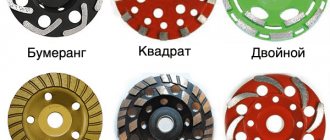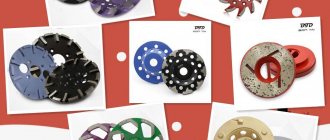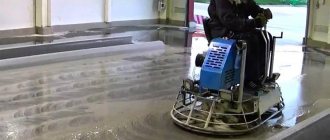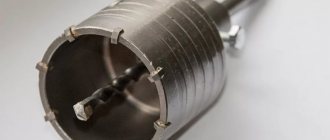In modern construction, natural and artificial stone is widely used due to its strength and aesthetic qualities. Concrete, brick, marble, granite - all this is an excellent material for houses and other structures. A distinctive property of these materials is their uneven, rough surface. For leveling and grinding, angle grinders are used - angle grinders (grinders) with diamond grinding cups as attachments. Their functions:
- destruction of irregularities and sagging;
- stripping the surface, removing the old layer of paint or other coatings;
- alignment of joints and seams;
- final cleaning and polishing.
Types of Diamond Cups
According to the manufacturing method, the following types of diamond cups for concrete are distinguished:
- Single row
- Double row
- With continuous sintered diamond layer
Single-row nozzles are characterized by low weight and good performance. Used for final polishing of concrete and creating a smooth edge. A small disadvantage is the difficulty of holding the tool on the surface when diamond grinding concrete.
Double-row discs are used for primary processing of concrete and elimination of visible screed defects. Cups with a circular layer of diamond chips are used for polishing natural stone.
Scope of application
The high reliability and wear resistance of the diamond cup make it unrivaled among other equipment for processing hard materials. Using the nozzle, you can scrape and grind concrete, brickwork, stone slabs, porcelain tiles, and paving slabs. Diamond discs are widely used for polishing natural stone - marble or granite. Operations performed using discs include rough, profiled and finishing grinding operations. Diamond cups are used for the following purposes:
- removal of screed sagging;
- roughening;
- alignment of seams;
- grinding joints;
- surface cleaning;
- removal of old or protruding layer;
- final polishing.
When installing attachments on an angle grinder, a dust extractor is usually used or the surface to be treated is moistened with water (wet grinding). This will help reduce dust and make cleaning easier.
are widely used during dismantling work. They effectively remove layers of used glue, hard-to-remove coatings (epoxy, plaster, plaster) and have a long service life. Grinding with a diamond cup saves time: it not only removes unnecessary layers, but also immediately levels the surface.
Nozzle in the form of grinding cups. Features of choice
Grinder discs for concrete: features and types
When choosing a tool, consider:
- Type of planned work. For each operation, special attachments are most effective. Using the wrong ones slows down the work or makes the process impossible, and quality suffers.
- The diameter of the cup, which should correspond to the power of the grinder. For accurate sanding of small areas, small attachments are more suitable. It is faster to work with large equipment, but its price is higher.
- Mounting hole, which must correspond to the size of the shaft. If the tool spindle is thinner, an O-ring is used: the fit on the shaft cannot be loose.
- The discs are designed for a rotation speed that the grinder cannot exceed.
The diamond grinding tool is marked with a marking that reflects:
- external diameter;
- cup depth;
- working edge width;
- segment height;
- mounting hole size.
Numbers in millimeters indicate characteristics in the sequence given above. The spraying parameters are indicated separately: diamond content in percentage, grain size in micrometers (µm). Coarse diamond powder is suitable for roughing and rough grinding; fine diamond powder is used for polishing.
How to choose a diamond cup
How to choose a good garden rake: varieties and selection criteria
To produce high-quality processing of a stone or concrete surface, you should carefully consider the choice of a diamond cup. Depending on the type of planned work, the diameter of the nozzle is selected - from 110 to 180 mm. To process small areas where careful sanding is necessary, you need to choose a small cup size. The greatest demand is for 125 mm concrete discs. There are nozzles with a diameter of more than 200 mm. Processing concrete with the help of such a cup is much faster. However, it should be remembered that as the diameter increases, the price also increases.
In accordance with GOST, the diameter of the mounting hole varies from 19 to 22.2 mm. The mounting hole must match the tool that is intended to be used. A loose cup fit can lead to injury and rapid wear of the diamond layer. But usually the attachment kit includes an adapter ring that allows you to use them with tools of different diameters.
All diamond grinding discs for concrete have special markings. It reflects the main characteristics in the following sequence:
- diameter of the outer circle (for example, 125);
- cup depth (40);
- working surface width (10);
- segment height (3);
- mounting hole (22).
All parameters are indicated in millimeters. The brand of diamond powder and the diamond content are specified separately. As a rule, it is 100%, but it can be less or more
Particular attention should be paid to the grain size (for example, 125/100 µm). Large fractions are suitable for rough grinding and roughing work, small fractions are suitable for fine polishing
The nozzle is selected to match the existing tool. The maximum permissible rotation speed of the disk must correspond to that of an angle grinder, since the safety of work depends on this. Each type of diamond cup has rotation speed restrictions. For example, for double-row cups it is 13,300 rpm.
The weight of the attachment and its balance are also important parameters when choosing a tool. The speed and comfort during surface treatment depends on this.
Varieties
We recommend reading our other articles
- How to choose a project for a garden house?
- Time to plant tomatoes in the greenhouse
- The attractiveness of using quartz vinyl tiles in your own home
- Quality and practicality of modern laminate
Metal discs for concrete work are divided depending on the application into:
- The “double segment” is used for rough work on concrete, eliminating defects in the concrete surface and uneven screed layer.
- “Boomerang” is used when carrying out finishing work. Diamond blades “Boomerang” are used for delicate processing of materials; they are distinguished by their low weight, high productivity, and soft operation.
- “Dolphin” is a gentle tool, wear-resistant, productive, and light in weight.
- Square diamond cups are the heaviest and are used for rough processes. They level concrete and increase its adhesion to other materials, in particular polymers.
- “Turbo” and “Typhoon” are the latest developments among grinding profiles. They have high performance, wear resistance and are used for processing dense concrete and other dense materials.
Tools with the addition of diamonds are highly effective; they qualitatively prepare concrete surfaces for the next stages of work and finishing.
Design features
Crown for concrete: types of crowns and design features
Cups for concrete are made of hardened steel with fused small fractions of diamonds. The nozzle is a product consisting of the following elements:
- Round concave base with elements for installation on high-speed electric tools.
- A grinding wheel for concrete, on which segments with diamond fractions are fused.
The bowl-shaped base has holes for cooling during operation. Diamond cutters are located in a circle on the working circumference of the disk, separated by certain intervals (slots). The slots also help cool the cup with air and, in the case of wet processing, with water.
The diamond cup for grinding concrete is attached to the spindle of the grinder using a nut; for this purpose, there is a special hole in the center of the base. Some models have a thread, and the tool can simply be screwed onto the shaft.
Definition
Diamond cups are discs with cutters that are located on one side of the product. The mount is located on the back of the tool. There are a lot of diamond chips fixed in the equipment.
Builders use a cup with a diameter of 230 millimeters for polished concrete surfaces, since the tool can withstand heavy loads. Diamond cup 125 is a durable metal disc with diamonds embedded in its base. The diameter of such discs is 100-230 millimeters, but most often specialists use a diamond cup with a diameter of 125 millimeters. The discs are installed on a manual grinding mechanism - an angle grinder
Selecting a sanding cup
Concrete grinding cup 125
Only a well-chosen grinding cup helps to process concrete efficiently and quickly. In addition to the individual characteristics of the tool, its mounting diameter must correspond to the parameters of the angle grinder used. The standard disc is a 125 cup for concrete grinding, the diameter of its mounting hole is 23 mm.
When choosing a tool, the following should be taken into account:
- Grinder power;
- The rotational speed of its shaft. It must correspond to the maximum permissible number of disk rotation speeds. The more accurate this ratio is, the safer the work will be;
- The presence of an adapter ring included with the nozzle allows the cup to be installed on any equipment;
- Disc weight and balance;
- Availability of good heat dissipation mode. This will increase the service life of the tool without loss of technical characteristics.
When choosing a diamond cup, you need to consider a number of characteristics:
- Sanding type: dry or wet. The wear resistance of the tool and the quality of the resulting surface depend on this;
- Purpose: hardness of the sanded material;
- Height of segments: High segments may sand faster, but in the end the surface will be rough with a high abrasive layer. Finish grinding is performed using diamond cups with a low segment height;
- Circle diameter. This parameter is determined depending on the conditions and scope of work, and the allowable space in the equipment;
- Tool cost. Often, expensive equipment has greater reliability and performance. In an inexpensive cup, diamonds may be of fairly low quality, which will not have a positive effect on the results of the work.
Flexible circles
The turtle is an elastic circle on which a layer of diamond powder and an adhesive polymer mixture is applied. The unique feature of this type of grinding wheel is that it can be used to process surfaces in hard-to-reach places. The flexible wheel for an angle grinder has high productivity and cutting ability that exceeds the similar characteristics of a conventional cutting disc by several times.
The turtle is used not only for processing building materials. It is used to polish granite, marble, precious stones and glass. If ordinary cutting wheels for grinders cannot be used for industrial devices, since they may not fit in size, then with a flexible disk the situation is completely different.
Modern industry is able to offer any working circles for power tools. All that remains is to choose the one suitable for the material being processed. You can opt for universal diamond wheels for an angle grinder, but you just need to take into account the amount of work ahead. Or maybe you should immediately buy both a flexible disk and a diamond cup to do everything quickly and efficiently.
Attachments and discs for concrete for grinders
Each tool used in conjunction with an angle grinder (angle grinder) is designed to perform the operations for which it is designed. The correct choice contributes to efficient and safe work with discs and attachments.
Cutting discs
Diamond cutting wheels are used to work with concrete. These are discs made of durable hardened steel with diamond coating on the cutting part.
These nozzles differ in the following design features:
- Cutting edge. It can be solid or with various slots. Segmentation increases the efficiency of air cooling during operation.
- The grain size of the diamond coating and the spraying method. The most reliable methods using laser welding and thermal bonding. Silver soldering allows operation with water cooling only. The electroplated diamond edge cuts only soft natural stones.
- The outer diameter of the circle. The correct size disks must be installed. Working without a protective cover is not only dangerous: the increased size of the nozzle leads to premature wear of the gearbox.
Diamond cutting can only cut material in a straight line. Curved sawing increases the load on the cutting edge, causing the diamonds to break.
Grinding discs for concrete
Concrete is ground to eliminate coating defects. Diamond wheels are used, which have a high abrasive ability and a long working life. Sometimes hard-alloy coated disks, the characteristics of which are lower, are called diamond. The efficiency of work is determined largely by the grain size of the working surface.
Depending on the concentration of diamonds, discs for grinding concrete are distinguished:
- grain size 40-80 (for pre-treatment);
- indicators 100-120 (for leveling the surface);
- grit 180-240 (for polishing).
The tool is a steel circle with soldered segments. Diamond powder is fixed to them with a special bond. It keeps the diamonds from being destroyed by the centrifugal force that occurs during rotation.
The designations on the discs consist of 2 or 3 numbers. The first number indicates the outer diameter, the second indicates the size of the mounting hole. The third number is not always present; it indicates thickness. For a grinding tool, this parameter does not play a big role.
Cleaning and roughening attachments
These attachments look like cups or circles. There are cutters and diamond discs. Twisted metal brushes are located around the circumference of the rollers. They strip metal and stone. The diameter of the wire varies depending on the purpose (scraping or stripping).
Purpose of an angle grinder
The peculiarity of the machine is its ability to process not only smooth surfaces, but also chamfers. This is achieved thanks to the angular placement of the working disk.
The device is universal and can be used to perform many jobs:
- The main operation for which an angle grinder is intended is grinding. Wide grinding wheels are used. Processing the ends with an eccentric grinder is difficult, but it is accessible for an angle grinder. The surface is ground with or without water cooling.
- Polishing with a grinder is also possible. To do this, use special diamond-coated polishing discs.
- Another operation that is performed with a grinder is res. The unit is not suitable for working with thick materials. Concrete or thick stone should be cut with special machines that have a water-cooled working wheel.
- An angle grinder easily cleans surfaces, removing dirt, paint, mastics, adhesives, and construction mixtures using abrasive attachments.
A grinder can be used instead of a wall chaser. A cutting disc is used to cut grooves for electrical cables and pipelines.
Main characteristics
Double-row bowls are considered more productive.
To make cups, a metal alloy and small fractions of diamonds are needed. This composition must be compressed in special forms. Since this grinding equipment is used for various purposes, it differs in several ways:
- type of binder;
- crumb size;
- location and type of cutters on the cup.
In addition, discs can be double-row or single-row. Double-row ones are considered more productive. They also have a long service life. At the same time, such discs are more expensive than other models.
With the help of a nozzle, builders are able to smooth out sagging and other defects that arise when molding a cement mixture. High-quality grinding allows you to make concrete walls smooth. This results in a perfectly polished surface. Cups are often used for various construction works. For example, when dismantling formwork from structures, nozzles are indispensable for leveling seams. However, they also have other advantages. Thus, they are used for the restoration of concrete products.
In addition, high-quality grinding discs weigh little, grind the surfaces of concrete structures well, allow you to restore old products, and are considered highly productive. With proper handling, the equipment will serve you for many years. Metal circles are produced with a diameter of 150-180 millimeters. Diamond equipment can be used both for grinding surfaces and for drilling concrete.
Features of grinding work
Diamond, as the hardest substance, effectively copes with the most difficult jobs of cleaning and grinding concrete screeds. To perform surface treatment, a diamond alloy cup is attached to the spindle of an angle grinder (grinder). The rotational motion that is transmitted to the disk is approximately 11,000 revolutions per minute. The high power of the tool on which the diamond concrete grinding cup is mounted also increases the productivity of the disc itself.
When working with hard surfaces, consider the following guidelines:
- The correct choice of nozzle in accordance with its purpose will greatly facilitate the processing of concrete.
- Before finishing grinding, rough grinding of edges and sagging is carried out to reduce the load on the disc.
- To break in the cup, it is necessary to carefully break it in in a gentle mode during the first few meters.
- The grinder should be held firmly with both hands to prevent impacts, especially when removing rough protruding defects.
- During operation, the cutter is pressed against the surface, but without increased pressure.
- Do not grind surfaces with breaks or cracks.
- To self-clean the nozzle, effectively cool it and reduce dust formation, it is recommended to supply water to the screed being treated.
- It is strictly not recommended to carry out work during frequent power outages or using faulty tools.
To avoid injury during work, you should use closed shoes made of thick, durable material. Compliance with these simple recommendations will ensure safety during work and extend the life of the diamond cup for construction concrete for an angle grinder.
Varieties
Based on the shape and number of diamond segments, cups are divided into several types, each of which is designed to work under certain conditions. Depending on this, the scope and purpose of the instrument changes.
The double-segment diamond cup is excellent for roughing sandstone, natural stone and concrete surfaces. The special profile allows the master to eliminate all defects in the material as efficiently and quickly as possible. The tool performs rough surface treatment, so to achieve a better result it is necessary to use a different attachment.
A cup with segments in one row has greater productivity and less weight, but it is noticeably more difficult to hold on the surface.
The segmented “Turbo” model is made in the form of a continuous row of diamond inclusions, which ensures the most accurate grinding of the working surface. It makes sense to use this attachment if you need to obtain the highest quality sanded surface. Using it, you can easily create edges and chamfers from granite and marble slabs. “Turbo” is often used by stone engravers when working on stone monuments. In addition, the attachment makes it relatively easy to create various bends on the surfaces of stone slabs. For more precise processing of stone surfaces, special diamond bits with a diameter of about 100 millimeters are sold in specialized stores. They are often used by professional craftsmen. In addition to increased accuracy, such models are distinguished by a long service life.
Model "Boomerang"
When doing finishing work, it is important for craftsmen to handle the material being processed as carefully as possible. For this purpose, a “Boomerang” diamond cup is usually used, the small diamond inclusions of which ensure the most delicate processing.
This attachment is especially popular among craftsmen, as it provides a softer and more stable stroke than double-row cutters, while not being inferior to them in terms of productivity.
Typhoon nozzles. Allows grinding and roughing work with hard and super-dense materials. With low weight they have a long service life and high wear resistance. And thanks to the special shape of the disc, the most effective removal of particles of ground material is achieved.
Diamond cup "Square". Standing out for its large mass, it is intended for coarser grinding. During operation, in addition to conventional grinding, the attachment provides the effect of chipping the material, which significantly reduces tool wear and increases the speed of work. Typically, the “Square” nozzle is used by craftsmen to process material before directly coating the surface with polymers. It is considered a rather rough cup, after which the surface is more rough, which in turn increases adhesion to other materials.
Surface preparation
Before grinding you must:
- Dismantle the old coating;
- Cut off all large growths;
- Make sure there are no metal fittings exposed to the surface. If there is one, cut it off with a grinder;
- Check the evenness of the surface with a three-meter ruler;
- Carry out an examination of the plane for the size of cracks and seams. If they are available, sealing is carried out using any hand tool with epoxy resin-based mastic;
- The floor and walls are tapped for strength. Refill if necessary.
Repairing Potholes
Concrete wall repair
Repairing potholes when renovating a property is important. After long-term use, the concrete surface becomes covered with potholes and bumps; their difference exceeds the permissible size of 5 mm. This requires removing defects before grinding begins.
In this case:
- Using a diamond wheel placed on a grinder, the damaged area is cut to a depth of at least 200 mm, and the material is removed;
- The cavity is cleaned from dust with a sandblaster;
- Treated with primer;
- After drying, it is sealed with a special compound;
- Using a lath or rule, the repair mixture is leveled.
After the solution has hardened, you can directly grind the concrete with a circle.
Small cracks are usually opened in a circle to a depth of 100 mm. The algorithm for performing the work is identical to eliminating potholes, but it is not necessary to remove the damaged area.
Surface grinding
Grinding with a diamond wheel does not correct mistakes that were made in the preliminary stages. It only removes the weakest concrete layer and slightly trims the resulting surface.
The instructions for carrying out the work are as follows:
- You can turn on the tool only after checking its serviceability;
- The reliability of the bowl is checked;
- The operating time of the equipment is no more than 15 minutes, after which it should be turned off to cool to room temperature;
- It is necessary to take care of a special suit that protects you from the dust that is generated during grinding;
- Measures are taken to ensure timely replacement of cups when they are worn out with similar ones in order to maintain high quality of work.
https://youtube.com/watch?v=seUHW_QgMX8
For mechanical processing of screeds, it is better to use bowls with a diamond grit of at least 400.
Features of wall grinding
Grinding a wall with a diamond cup
When processing walls, it is necessary to take into account some nuances. Concrete walls cannot be sanded using equipment used for floor work. This is due to the high gravity that interferes with its operation.
When sanding walls, as shown in the photo:
- It is rational to use hand-held grinding machines with large-grain diamond bowls;
- It is better to start the processing process from any corner;
- It is most rational to carry out sanding in small strips, starting from the ceiling, moving towards the floor;
- From time to time it is necessary to check the evenness of the wall with a level, and move on to the next strip after obtaining an even vertical line on the previous one;
- If putty has been applied to the walls, do not use excessive zeal so as not to remove all of it. Otherwise, the work will need to start again.
Cleaning a repaired crack
Leveling the floor
The video in this article will tell you in detail about grinding concrete walls and floors.
https://youtube.com/watch?v=wHNhxkUe-d8
If a concrete sanding cup is used to finish the surface of walls or floors, the texture of the material looks better. At the same time, small differences in the concrete are smoothed out, and the surface acquires better qualities not only in appearance, but also in performance characteristics.
When is concrete grinding needed?
Sanding a concrete wall
After concrete is applied to the floor, an unstable layer forms on its top layer after hardening. From interaction with an external aggressive environment, exposure to mechanical loads, the surface can easily be destroyed.
To obtain a monolithic and durable concrete base, this collapsing layer must be cut off. Diamond cups for grinding concrete help to do this.
In addition, the use of such a diamond disc allows you to solve other problems:
- Grinding the dried concrete screed will make the surface smooth, it will become even, without minor flaws: dimples, tubercles, ripples;
- When grinding concrete that has been in use for a long time, it is possible to remove remnants of the old floor covering and traces of rather complex contaminants from its surface;
- After the process, the water resistance of the concrete surface increases several times;
- The level of dust formation is minimized;
- The strength and resistance of the surface to moisture, harmful chemicals, and temperature changes increases;
- The cost of maintaining the concrete base is reduced;
- A grinder and a diamond cup attached to it for grinding concrete allow you to give a nondescript concrete floor an attractive appearance.
Concrete grinding becomes an indispensable technological process after pouring the floor with self-leveling mixtures, applying various impregnating compounds or thin-layer paints. Grinding is used in commercial and administrative buildings, industrial buildings, and for arranging areas in front of buildings.
Tool characteristics
Diamond blades with a diameter of 125 and 230 mm are used for various types of concrete grinding.
She may be:
- Chernovaya;
- Profiled;
- Finish.
To make cups, a metal alloy and fine diamonds are used. This composition is compressed in special forms. The use of disks for different purposes determines their parameters.
They differ:
- Types of binder;
- Crumb size;
- Location and types of cutters on the cup.
In addition, discs can be: double-row, single-row. More reliable, durable and productive - double-row. But the price of such discs is higher than that of other models.
Advantages and applications of polished concrete floors
Treated concrete floors have gained great popularity among finishing coatings not only in the public but also in the private category. It is mainly used:
- in medical and educational institutions;
- in shopping and sports centers;
- in water parks;
- in entertainment establishments;
- at cultural venues;
- in suburban areas;
- as a floor covering in outbuildings and garages;
- Increasingly, polished concrete floors can be found in dressing rooms and corridors in the homes of ordinary citizens.
It has earned such a wide range of applications due to its performance characteristics, which in many ways exceed the advantages of even the highest quality finishing coatings:
- the service life is estimated at decades, which is ensured not only by its increased strength characteristics, but also by its resistance to moisture saturation. An ordinary concrete screed without a finishing coating or treatment does not have such significant advantages;
- the floor sanded to a gloss is similar to elite self-leveling coatings;
- affordable cost;
- is an ideal basis when a perfectly flat base for a decorative coating is required;
- does not produce harmful dust during operation;
- grinding makes it possible to level substrates even with strong relief;
- does not require periodic repairs. If such a need arises, then making a “patch” will not be difficult.
In order for the topcoat to retain these properties for as long as possible, the poured concrete floor must be properly sanded. If the filling is old, not only the decorative layer, but also the main layer is polished. If a new concrete floor is installed, laitance will need to be removed. Also, grinding concrete surfaces with special tools is an integral part of preparing the base for self-leveling floors.
Be careful and do not fall for the common misconception - grinding does not solve the problems of adjusting the relief surface. Leveling is carried out at the stage of primary pouring or re-driving of the concrete layer.











